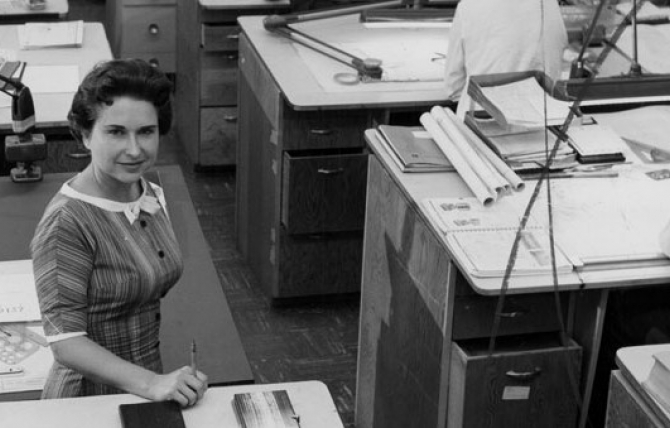Betty Edwards of Canoga Park is UCLA engineer. Her work is designing installation of electrical utilities throughout Rocketdyne facilities in Valley. Women play important part in company's space age. 1959.
For many, the predominant image of the post-War woman is the suburban mom and consummate homemaker as immortalized in television characters of the period such as Donna Stone (The Donna Reed Show), Harriet Nelson (The Adventures of Ozzie and Harriet), and June Cleaver (Leave it to Beaver). This figure did indeed exist in suburban homes throughout the county and was a vital part of the social fabric, but she wasn’t the sole feminine representative in the post-War era.
Life Magazine ran an extensive article in 1947 discussing the "American Woman's Dilemma." Should she seek a family? A career? Is it possible to have both? Once her children are raised, will she have anything interesting to discuss with her husband? In the 1930s & early 1940s, many women had entered the workforce because of financial necessity spurred by the Great Depression or the home-front manpower shortages of World War II. For many (though certainly not all) women in the post-War era, pursuing a career did indeed become a decision more than a necessity. The American woman's dilemma could present itself, and the various paths chosen during this time were heavily documented by the Valley Times newspaper.
Published out of North Hollywood as a daily newspaper from 1946-1970, the Valley Times documented the entire San Fernando Valley, a region that was emblematic of the tremendous suburban development boom that was taking place outside of urban centers around the country. Groundbreakings, ribbon cuttings, school openings, and various civic activities became common themes of the newspaper and could at times reflect the picture perfect green-lawned life of the Cleavers. The editors of the Valley Times themselves seemed to have viewed its female readership as very Donna Reedesque when advertising a Women's section in 1961 which catered to the "number of things that almost every woman would like to be - gay and frivolous, sound and practical, fashionable, attractive, a charming companion, a clever conversationalist and a gracious homemaker."
However, in covering the various goings on in the San Fernando Valley during this time, the newspaper also unwittingly documented a population of diverse and dynamic women trying to establish their own unique identities in a seemingly homogenized suburban culture. Yes, the homemakers and beauty queens found representation in the pages of the Valley Times, but there also existed women of various ethnic backgrounds who were politically active, valued the advancement of education for the youth population, and formed clubs which championed charitable causes, not to mention that wide swath of those who developed professional careers; musicians, artists, librarians, flight attendants, police sergeants, nurses, doctors, pharmacists, engineers, business owners, architects, stock brokers, and physicists are just some of the positions held by women of the Valley and no doubt could be found amongst the female population across the country.
The newspaper also documented those who were uniquely "Valley Girls." By the 1950s, the San Fernando Valley had long been home to a numbers of folks from the entertainment industry and the Valley Times did not shy away from covering these people. Unlike today, where celebrities are predominately documented in pure social settings, the celebs of the post-War Valley were civically engaged in their communities, contributed their time to charitable causes, and took titles such a "honorary mayor" seriously. Along with these women of entertainment were the pioneers who took great pride in their long Valley lineage and sought to preserve local history for future generations. Let's not forget the Valley's own "Rockettes" of Rocketdyne, the rocket engine design and production company in Canoga Park who employed over 2,200 women in posts ranging from secretary to rocket scientists and everything in between.
The Los Angeles Public Library has been the custodian of the vast photographic collection of the Valley Times for over 30 years. Advances in technology have not only allowed us to gradually make the images of the newspaper readily accessible online but have also made it possible for us to discover the not so obvious themes permeating throughout the collection such as the diverse women of the San Fernando Valley who strove to define their identities.
